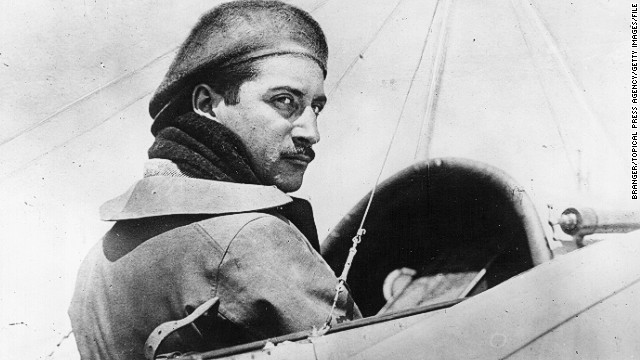Roland Garros, hero of the air ... and tennis?
In French sporting culture the name Roland Garros is
synonymous with tennis, as the title of the home of the French Open. However,
Monsieur Garros had very little to do with tennis. Robert Wohl has even claimed
that he was terrible at most physical sports. He was instead a hero of the air;
one of France’s first aviators.
 |
| Roland Garros, aviator (source) |
Having gained his pilot’s licence in 1910, he was one of
France’s first sporting pilots, flying in competitions such as the Paris-Madrid
Air Race. In 1913 he gained acclaim for being the first man to fly non-stop
across the Mediterranean, from the south of France to Tunisia. He made the
800km journey in just eight hours. Aged only 25, he was at the forefront of
aeroplane development.
At the outbreak of the First World War he was, ironically,
teaching military flight in Germany. He escaped home to France and enlisted as
a reconnaissance pilot in Escadrille 26 of the French Air Force. Not only was
he a successful aviator but he also helped develop aerial technology. He helped
create a system which allowed a pilot to fire a machine gun forwards, but to avoid
hitting the propeller by way of steel wedge deflectors. This improved the
efficiency and consistency of air warfare. In the first three weeks of April
1915 he shot down three German aeroplanes.
 |
| The Garros deflector system (source) |
Despite this advantage, Garros was forced to crash land in
German territory on 18th April. There are conflicting reports of
whether the crash was caused by a technical fault or by being shot by ground
fire. He survived the fall but was unable to destroy his aeroplane. As a
result, he was taken prisoner and his plane was used by German designer Fokker
to improve their air force.
 |
| Garros' memorial in Vouziers (source) |
For the second time in his life Garros had to escape from Germany
and after many attempts, he escaped from the POW camp in February 1918. He
returned to service in the French Air Force, where he shot down another plane on
2nd October. However, three days later and on the eve of his
thirtieth birthday, he was shot down and killed above the Ardennes, most likely
by the German ace Habich. He is buried in the communal cemetery at Vouziers,
near Bastogne in Belgium.
Roland Garros had four confirmed victories during the Great
War, meaning that he is not technically considered a flying ace (which requires
five victories), although he had claimed at least one other kill. He is
nonetheless considered a French hero both for his war service and his pre-war
pioneering of aviation. The day after his death he was posthumously awarded the
Legion d’Honneur for his services.
A decade later, Paris was in need of a new tennis stadium in
which France could host the Davis Cup as the reigning champions. The new
stadium was to be built in Paris’ 16e arrondissement, where the young Garros
had attended Lycee Janson de Sailly. It is
recorded that he played tennis during this time, but without much success. His
main interest at this time had been music, although this was soon to be replaced
by his love of aviation that would last his lifetime.




While his connection to sport and to Paris has come to
represent his legacy in Europe, a more fitting tribute remains to him on his
birth island of La Reunion where the international airport still bears his
name. One of France's first successful aviators, he was a pioneer of both adventure and military aviation. His name lives on at the centre of French culture, even if not solely for his contribution to aviation technology.
Kathryn
Kathryn


No comments: